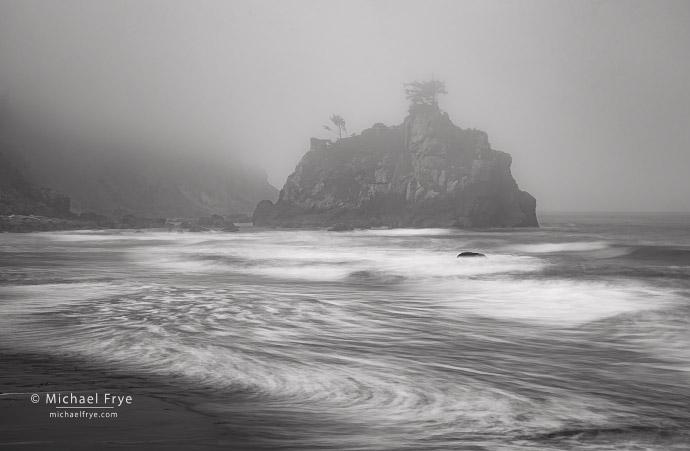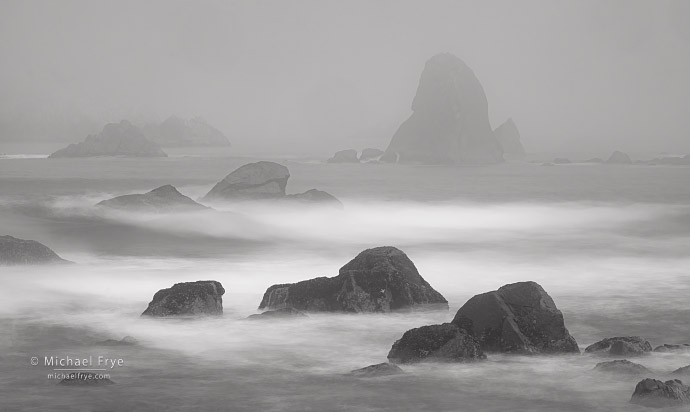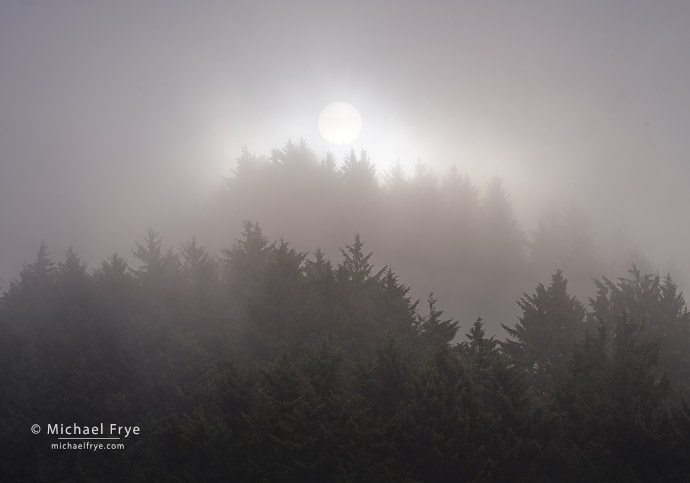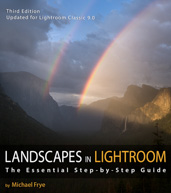
Sea stack and swirling waves, Northern California coast. 55mm, 3 seconds at f/16, ISO 200, ND filter. Timing was vitally important in making this photograph. I made 92 exposures with this exact same composition and camera settings, but only one had this zigzag wave.
Back in early June, before, during, and after our redwoods workshop in Northern California, we had many days with low fog along the coast. That’s somewhat unusual up there. It’s more typical to see the fog layer rise up a bit, where it looks like a low overcast at sea level, but if you can climb higher you might be able to get into the clouds, and into the fog.
That higher stratus deck usually works better for finding fog in redwood groves, since redwoods don’t grow at low elevations near the shore (there’s too much salt spray for them). But I love photographing low fog along the coast, with sea stacks and rock outcrops looming out of the mist. Fog is so common in these coastal areas that photographing these scenes in fog actually seems more characteristic, more typical, than photographing them on a sunny day, or even with a great sunset. I think of these shores as brooding and mysterious, so I like working with weather that enhances that mood.
With or without fog, ocean scenes are dynamic, with constant movement from the waves, so shutter speeds and timing are always important. In the photograph above I experimented with different shutter speeds until settling on three seconds. (I had to use a neutral-density filter to get such a slow shutter speed without overexposing the image.) That was slow enough to smooth the water, yet fast enough to preserve some of the shapes of the waves.
But finding the right shutter speed is just the first step. Timing is just as important. Every wave is different, and some waves work better than others. For this scene I exposed frame after frame, trying to capture moments when the waves had interesting shapes and patterns. For this one scene I exposed 92 frames with the exact same composition and camera settings. And I wasn’t just randomly firing off one exposure after another. I waited until a promising set of waves came in, then tripped the shutter two or three times as that set came ashore.
A number of those images worked pretty well. But the one shown above stood out, with a beautiful zigzag shape to the foreground wave. I think the three most important components of any photograph are composition, light, and timing – the moment you press the shutter. Many photographers make concerted efforts to master the first two – but don’t overlook the last one.
— Michael Frye

Rocks and sea stacks in fog, Northern California coast. 187mm, 4 seconds at f/16, ISO 200, ND filter.

Sun breaking through fog, Northern California. 238mm, 1/60 sec. at f/16, ISO 100. Standing on a beach one morning, the sun briefly appeared through the fog. I had to quickly change lenses, and captured three frames before the sun disappeared again.
Related Posts: The Wild Coast; Shutter Speeds and Mood
Michael Frye is a professional photographer specializing in landscapes and nature. He lives near Yosemite National Park in California, but travels extensively to photograph natural landscapes in the American West and throughout the world.
Michael uses light, weather, and design to make photographs that capture the mood of the landscape, and convey the beauty, power, and mystery of nature. His work has received numerous awards, including the North American Nature Photography Association’s 2023 award for Fine Art in Nature Photography. Mich
ael’s photographs have appeared in publications around the world, and he’s the author and/or principal photographer of several books, including Digital Landscape Photography: In the Footsteps of Ansel Adams and the Great Masters, and The Photographer’s Guide to Yosemite.
Michael loves to share his knowledge of photography through articles, books, workshops, online courses, and his blog. He’s taught over 200 workshops focused on landscape photography, night photography, digital image processing, and printing.









Thanks, Michael, for these lovely, haunting, coastal images. It’s amazing how much depth and interest fog can bring to an image. I’ve spent many hours working with shutter speed and trying to get the essential timing when taking images of the sea. Hope your summer is going well!
Thanks very much Bob! My summer is going well, thanks, and I hope yours is too.